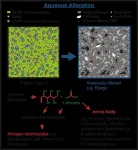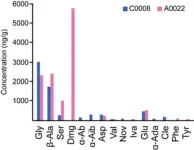(Press-News.org) Our solar system formed from a molecular cloud, which was composed of gas and dust that was emitted into the interstellar medium (ISM), a vast space between stars. On collapse of the molecular cloud, the early sun was formed, with a large disk of gas and dust orbiting it. The dusty material collided to produce rocky material that would eventually grow in size to give large bodies called planetesimals.
The planetesimals that formed far enough from the sun, also contained large quantities of ice. The ice consisted of water and other volatile compounds, such as carbon monoxide (CO), carbon dioxide (CO2), methanol (CH3OH) and ammonia (NH3), as well as many other organic compounds, likely including some amino acids. Eventually, the ice melted due to the presence of radioactive material that heated up the bodies. This period of liquid water (termed aqueous alteration) enabled many reactions to occur, including Strecker synthesis and Formose-like reactions, the result being the production of new organic material, including amino acids (Figure 2). The same process also changed the rocky materials from their original minerals to new secondary minerals, such as phyllosilicates, carbonates, Fe-oxides and Fe-sulfides (Figure 1).
After several millions of years, the planetesimals began to freeze, as the radioactive material was used up. Later catastrophic collisions and interaction with the solar systems planets broke up the large bodies and sent their asteroidal and cometary fragments close to Earth. Further impact events have since delivered fragments of these asteroids and comets to the Earth’s surface, supplying the Earth with large quantities of organic material, including amino acids, over the course of its history.
Amino acids are within all living things on Earth, being the building blocks of proteins. Proteins are essential for many processes within living organisms, including catalysing reactions (enzymes), replicating genetic material (ribosomes), transporting molecules (transport proteins) and providing a structure to cells and organisms (e.g. collagen). Therefore, amino acids would have been needed in significant amounts within the region where life began on Earth.
Previous work has identified a number of possible settings both on the Early Earth and in extraterrestrial environments that can form amino acids. Interestingly, most amino acids come in at least two forms, whose structures represent mirror images of each other, similar to human hands. Accordingly, these are often referred to as the right-handed or left-handed optical isomers. One interesting characteristic of life on Earth is that it uses one particular type of amino acids in its proteins, the left-handed optical isomer. Currently, only a certain class of meteorites (carbonaceous chondrites) are known to contain excesses of left-handed optical isomers, which has led to the idea that the amino acids used by life may have originated from these meteorites. Despite this, the amino acids in meteorites could have formed before their incorporation into the meteorites or after the meteorites had already formed.
Here, a team of scientists analysed several fragments of the asteroid Ryugu and calculated the abundance of amino acids within them. The abundance of the mineral phases within the particles had been previously reported in another publication, which allowed for a comparison between the abundance of amino acids and minerals. It was found that one particle (A0022) contained a high abundance of an amino acid that is uncommon in extraterrestrial materials, called dimethylglycine (DMG), whereas the other particle (C0008) did not contain this amino acid above detection limit (Figure 3). Meanwhile, the abundance of the amino acid glycine was found to be lower in A0022 compared to C0008, while the abundance of β-Alanine showed the opposite trend. Accordingly, the ratio of β-Alanine to glycine was higher for A0022 than for C0008. This ratio was shown previously to be indicative of the extent of aqueous alteration operating on planetesimals. Accordingly, it was hypothesised that some reaction related to higher levels of aqueous alteration in A0022 may explain the high abundance of DMG in this particle, compared to C0008.
As such, the mineral phases were examined to see if any additional evidence for what reaction may be causing the different amino acids abundances between the Ryugu particles. It was found that the abundance of secondary minerals (formed after aqueous alteration), including carbonate, magnetite and Fe-sulfides, was higher in A0022 than in C0008 (Figure 4). In particular, the high abundance of carbonate pointed towards a larger quantity of CO or CO2 within the region of the planetesimal where A0022 had been altered, compared to C0008. In conjunction with the evidence for more intense aqueous alteration from the β-Alanine to glycine ratio, this indicated that more ice in general may have been present in the precursor of A0022 than in C0008 (Figure 4).
One way to commercially produce DMG, an important nutrient for humans, is the through the Eschweiler–Clarke reaction. This reaction requires the interaction of glycine with formic acid and formaldehyde in water and also produces CO2. Glycine, formaldehyde and formic acid are all found in comets and so it is expected that they would be present in the planetesimal precursors of asteroids. Therefore, if the Eschweiler–Clarke reaction occurred during aqueous alteration within the precursor of A0022, then it could explain the high level of DMG and lower abundance of glycine in this particle, compared to C0008 (Figure 4). Additionally, the CO2 produced could have further contributed to the formation of carbonates in A0022.
Overall, the findings of the study indicate that slight differences in the conditions present during aqueous alteration on planetesimals can have big effects on the end abundances of amino acids. Some amino acids can be destroyed and others created and this in turn will affect the availability of amino acids at the origin of life on Earth.
END
How were amino acids, one of the key building blocks of life, formed before the origin of life on Earth? Tiny particles from the near Earth asteroid Ryugu can help answer this profound question
The amino acid abundances of two Ryugu particles were measured and compared with their rocky components. The results demonstrate the important role that water plays in the formation of amino acids on the giant precursors of asteroids like Ryugu
2023-04-05
ELSE PRESS RELEASES FROM THIS DATE:
Air pollution is linked to lower COVID-19 vaccine responses
2023-04-05
People exposed to higher levels of air pollution before the pandemic had lower antibody responses to COVID-19 vaccines, according to a study led by the Barcelona Institute for Global Health (ISGlobal), an institution supported by “la Caixa” Foundation, in collaboration with the Germans Trias i Pujol Research Institute (IGTP). In particular, exposure to fine particulate matter (PM2.5), nitrogen dioxide (NO2) and blank carbon (BC) was associated with about a 10% decrease in IgM and IgG antibody responses in people without prior infection. The findings, published in Environmental Health Perspectives, ...
More than a third of children worry at least once a week, with their tendency to worry progressing with age, according to national survey by Nemours KidsHealth(R)
2023-04-05
WILMINGTON, Del. (April 5, 2023) – More than one in three children ages 9 to 13 (37%) worry at least once a week, primarily about school (64%) and friendships (41%), with their tendency to worry progressing with age. Older children (age 13) are more likely than their younger counterparts to report feeling as though they will never stop worrying (48% vs. 22% for 9-year-olds). This is according to the results of What’s Worrying America’s Kids, a national survey conducted by The Harris Poll on behalf of Nemours KidsHealth. The survey results ...
TOS endorses global editorial on people-first language and pediatric obesity
2023-04-05
ROCKVILLE, Md.—The Obesity Society (TOS) has joined several European, US and Canadian obesity organizations in an editorial statement published in the journal Pediatric Obesity championing the use of people-first language for pediatric overweight and obesity to address weight stigma and bias.
Professor David Thivel, president of the European Childhood Obesity Group and coordinator of the joint statement, said, "This paper emphasizes the importance of considering the use of people-first language when it comes to pediatric obesity, by all who work with, care for or support children and adolescents, in order to avoid stigmatization and to create an appropriate and optimal ...
Complications for procedure to open clogged pulmonary arteries decrease significantly
2023-04-05
For patients with high blood pressure in their pulmonary arteries caused by chronic blood clots, complications after a minimally invasive balloon angioplasty have decreased substantially over the last decade, a Michigan Medicine-led study finds.
Researchers examined over 7,500 cases of balloon pulmonary angioplasty for patients with chronic thromboembolic pulmonary hypertension, an elevated blood pressure in the pulmonary arteries due to persistent blockages known as CTEPH, between 2013 and 2022. The procedure, which is offered ...
New tool shows progress in fighting spread of invasive grass carp in Great Lakes
2023-04-05
New research reveals the progress scientists at The University of Toledo are making in their ongoing efforts to capture and remove invasive grass carp from the Great Lakes.
Researchers based at the UToledo Lake Erie Center created a new way to estimate the abundance of invasive “sleeper” species in freshwater ecosystems and help guide management strategies.
Using data collected during their efforts to remove invasive grass carp from Lake Erie and its tributaries, the aquatic ecologists and environmental ...
Recent advances in space chemistry research
2023-04-05
Space is the great unknown — very few of us will ever experience what it’s like to visit another planet or moon, and so much is yet to be discovered. Below are some recent papers published in ACS journals that report advances toward understanding whether certain minerals, compounds or even life itself could form on other worlds. Reporters can request free access to these papers by emailing newsroom@acs.org.
“Immunoanalytical Approach for Detecting and Identifying Ancestral Peptide Biomarkers in Early Earth Analogue Environments”
Analytical Chemistry
March 16, 2023
These authors reasoned that if they could analyze “resurrected” ...
Survey of allergists/immunologists reveals management of hereditary angioedema differs by region
2023-04-05
ARLINGTON HEIGHTS, Ill. (April 5, 2023) – Hereditary angioedema (HAE) is a disease that, due to its rare nature, can pose difficulties for both patients and medical professionals. A new survey of allergists/immunologists from the American College of Allergy, Asthma and Immunology (ACAAI) shows that diagnosing, treating and managing this condition can be challenging for patients and healthcare providers - including patients in rural areas. An article about the survey is published in Annals of Allergy, Asthma and Immunology, ACAAI’s scientific journal.
HAE is caused by a genetic mutation, and there are different types. It is a hereditary disease. The symptoms of HAE ...
SynGAP Research Fund awards a collaborative grant to Tang Lab & AXONIS Therapeutics
2023-04-05
PALO ALTO, Calif. (April 5, 2023) – SynGAP Research Fund (SRF), a 501(c)(3) public charity whose mission is to improve the quality of life for SYNGAP1 patients through the research and development of treatments, therapies and support systems, today announced they have awarded a $130,000 collaborative grant to the lab of Xing Tang, PhD at Boston Children's Hospital & AXONIS Therapeutics to investigate the treatment effects of KCC2-enhancing small molecule compounds in SYNGAP1 haploinsufficiency.
Principal Investigator of translational neuroscience at AXONIS, Dr. Kadam, has been working with the SRF community for many years. While at Johns Hopkins, she gave a popular SRF ...
Manganese in Central Valley water threatens fetuses and children
2023-04-05
Water in California’s Central Valley contains enough manganese to cause cognitive disabilities and motor control issues in children, and Parkinson’s-like symptoms in adults.
A naturally occurring metal, manganese is found in water supplies throughout the world. It is regulated as a primary contaminant in many Southeast Asian countries where the climate causes it to leach into groundwater. However, in the U.S. it is regulated only as a secondary contaminant, meaning no maximum level is enforced.
A ...
Do altered gut microbes affect risk of attention-deficit/hyperactivity disorder?
2023-04-05
New research published in the Journal of Child Psychology and Psychiatry suggests that the microbial composition of the gut may affect a child’s susceptibility to attention-deficit/hyperactivity disorder (ADHD).
The human gastrointestinal tract hosts a large population of microorganisms such as bacteria, viruses, and fungi. When investigators compared fecal samples from 35 children with ADHD and 35 healthy controls, samples from children with ADHD had higher levels of certain species of fungi and lower levels of other species.
In experiments with cells grown in the lab, one species in abundance in ...
LAST 30 PRESS RELEASES:
Norbert Holtkamp appointed director of Fermi National Accelerator Laboratory
New agentic AI platform accelerates advanced optics design
Biologists discover neurons use physical signals — not electricity — to stabilize communication
Researchers discover that a hormone can access the brain by hitchhiking
University of Oklahoma researcher awarded funding to pursue AI-powered material design
Exploring how the visual system recovers following injury
Support for parents with infants at pediatric check-ups leads to better reading and math skills in elementary school
Kids’ behavioral health is a growing share of family health costs
Day & night: Cancer disrupts the brain’s natural rhythm
COVID-19 vaccination significantly reduces risk to pregnant women and baby
The role of vaccination in maternal and perinatal outcomes associated with COVID-19 in pregnancy
Mayo Clinic smartwatch system helps parents shorten and defuse children's severe tantrums early
Behavioral health spending spikes to 40% of all children’s health expenditures, nearly doubling in a decade
Digital cognitive behavioral treatment for generalized anxiety disorder
Expenditures for pediatric behavioral health care over time and estimated family financial burden
Air conditioning in nursing homes and mortality during extreme heat
The Alps to lose a record number of glaciers in the next decade
What makes a good proton conductor?
New science reporting guide published for journalists in Bulgaria
New international study reveals major survival gaps among children with cancer
New science reporting guide published for journalists in Turkey
Scientists develop a smarter mRNA therapy that knows which cells to target
Neuroanatomy-informed brain–machine hybrid intelligence for robust acoustic target detection
Eight SwRI hydrogen projects funded by ENERGYWERX
The Lundquist Institute and its start-up company Vitalex Biosciences Announces Strategic Advancement of Second-Generation fungal Vaccine VXV-01 through Phase 1 Trials under $40 Million Competitive Con
Fine particles in pollution are associated with early signs of autoimmune disease
Review article | Towards a Global Ground-Based Earth Observatory (GGBEO): Leveraging existing systems and networks
Penn and UMich create world’s smallest programmable, autonomous robots
Cleveland researchers launch first major study to address ‘hidden performance killer’ in athletes
To connect across politics, try saying what you oppose
[Press-News.org] How were amino acids, one of the key building blocks of life, formed before the origin of life on Earth? Tiny particles from the near Earth asteroid Ryugu can help answer this profound questionThe amino acid abundances of two Ryugu particles were measured and compared with their rocky components. The results demonstrate the important role that water plays in the formation of amino acids on the giant precursors of asteroids like Ryugu




